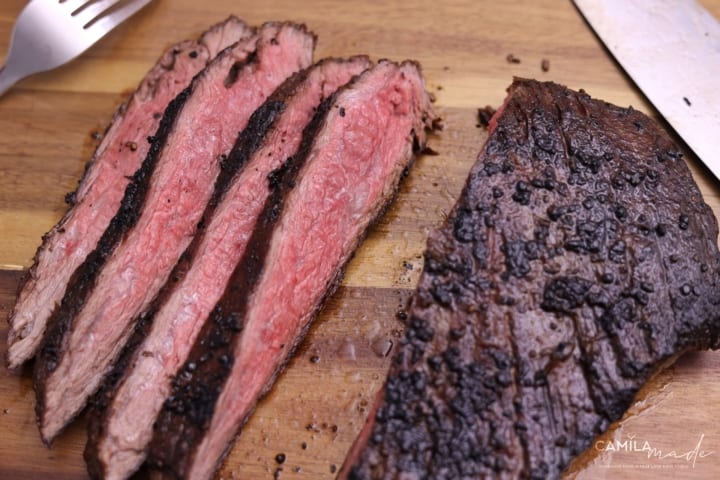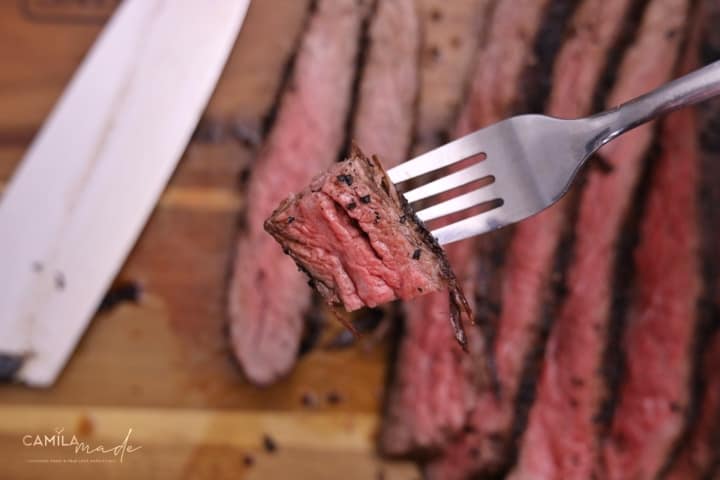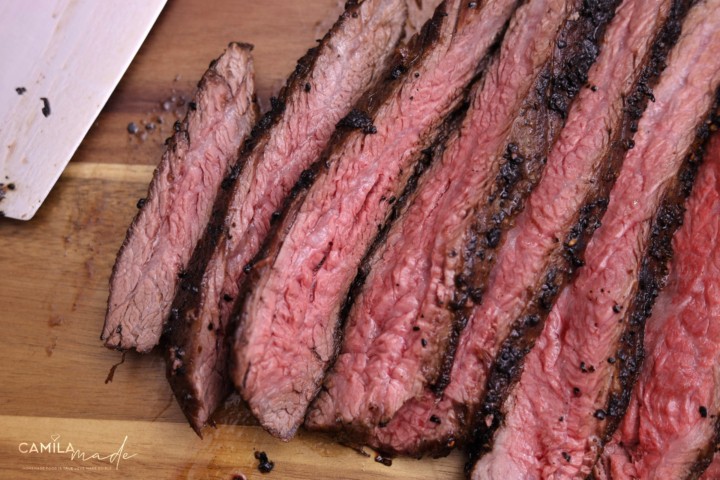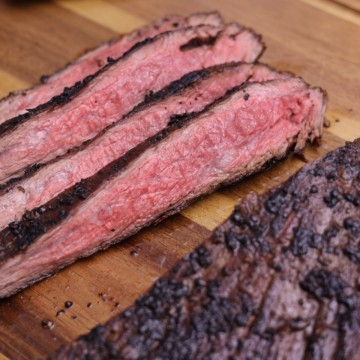If you're a meat lover looking for a flavorful and juicy cut of beef, vacio is the perfect choice. This essential cut is a popular feature on any Paraguayan grill and has gained popularity around the world.
With its distinctive taste and tender texture, vacio is located in the lateral region of the hindquarter of the cow and can be prepared in a variety of ways.
While vacio is typically prepared on the grill, in this recipe, we'll show you how to broil it. Broiling is a quick and easy cooking method that produces similar results to grilling. By broiling the vacio, you'll still be able to enjoy its delicious taste and tender texture, but with the convenience of using your oven.
Jump to:
Traditional Paraguayan Asado, "grilled steak", is all about showcasing the beef's natural flavor. That's why you'll rarely find marinades or spice rubs in this cuisine. Instead, a special grilling salt called sal parrillero, also known as "sal gruesa," is often used to enhance the meat's flavor.
This coarse salt has large grains that dissolve slowly, making it perfect for slow-grilling beef. By using sal parrillero in your Asado, you can add a unique Paraguayan touch to your dish while still allowing the natural taste of the beef to shine through. Vacio is typically served with sides such as Sopa Paraguaya, cooked yuca, or chorizo, which complement the rich and savory flavor of the meat.
Beyond its delicious taste, vacio holds great cultural and historical significance in Paraguay. As a staple of Paraguayan cattle ranching and meat production, this cut represents the country's culinary identity and serves as a reminder of its rich cultural heritage. Enjoying a flavorful serving of vacio is not just a meal but a way to experience the unique flavors and traditions of Paraguayan cuisine. So, let's get started with this easy and delicious broiled vacio recipe!
Cooking Times for Grilled Vacio
Gas Grill Charcoal Grill
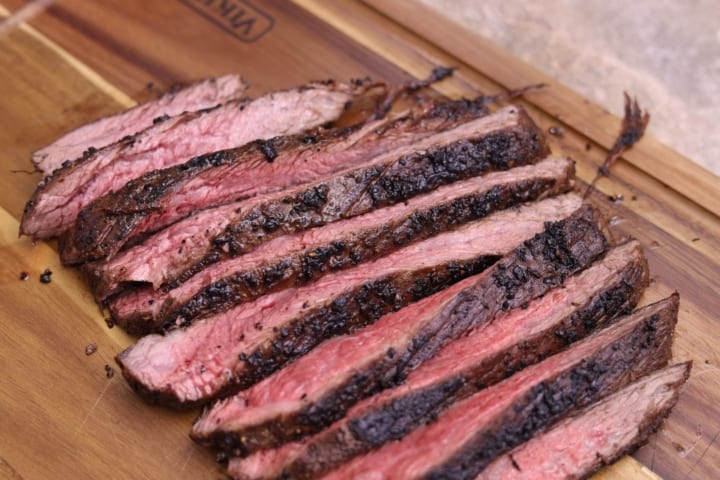
Measuring Doneness for Vacio
When cooking steak, it's important to remove them from the heat before they reach its desired internal temperature. As a general rule of thumb, you should take the steak off the grill when it is about 5°F below the target temperature in your recipe or cooking guide.- Rare Flank Steak (125ºF)
- Medium-Rare Flank Steak (135ºF)
- Medium Flank Steak (145ºF)
- Medium-Well Flank Steak (155ºF)
- Well Done Flank Steak (165ºF)
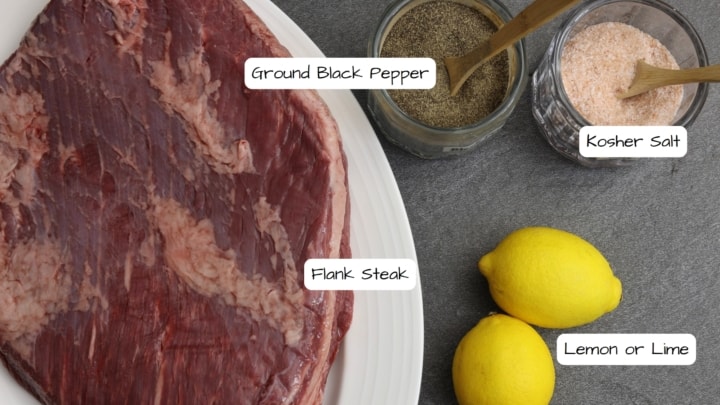
How to Make Vacio
Note: The full instructions are provided in the recipe card below.
Leave the Vacio at room temperature for an hour before proceeding to cook. Move an oven rack as close to the broiler as possible. Preheat the broiler. Line a rimmed baking sheet with aluminum foil.
Place an oven-safe wire rack inside the baking sheet. Season each side of the meat with 1 teaspoon of kosher salt and 1 teaspoon of ground black pepper. Sprinkle the zest of 1 lemon on both sides, and then massage with your hands to distribute the seasonings, pressing the salt, black pepper, and lemon zest into the surface of the meat.
Place the steak on the prepared wire rack. Add the baking sheet to the oven rack and broil until nicely brown, about 5 to 6 minutes, watching closely to avoid overcooking. Squeeze ½ lemon or lime juice over the steak. Flip the steak and squeeze the remaining ½ lemon or lime juice over the steak.
Broil until nicely brown, about 5 to 6 minutes. Remove the steak when a meat thermometer reads 125-130 degrees Fahrenheit for medium-rare. Place the steak on a cutting board tented with aluminum foil, and let them rest for 5-10 minutes before serving.
Note: Keep in mind that this recipe is a basic guideline, and cooking times may vary depending on the thickness of the Vacio and individual oven settings. For the best results, we recommend using a meat thermometer to ensure that the meat is cooked to your desired level of doneness. Additionally, it's important to let the Vacio rest after cooking, as this allows the juices to redistribute throughout the meat, making it more tender and flavorful. Resting the meat for several minutes will ensure that your Vacio is moist and juicy when you slice it."
Related Recipes:
Recipe
Vacio
Tools
- Oven-safe wire rack
Ingredients
- 1 flank steak , about 2 to 2½ pounds
- 2 teaspoons ground or freshly cracked black pepper , divided
- 2 teaspoons freshly cracked sea salt or kosher salt , divided
- 1 lemon or lime , zested, then cut in half
Instructions
- Leave the Vacio at room temperature for an hour before proceeding to cook. Move an oven rack as close to the broiler as possible. Preheat the broiler. Line a rimmed baking sheet with aluminum foil. Place an oven-safe wire rack inside the baking sheet. Season each side of the meat with 1 teaspoon of kosher salt and 1 teaspoon of ground black pepper. Sprinkle the zest of 1 lemon on both sides, and then massage with your hands to distribute the seasonings, pressing the salt, black pepper, and lemon zest into the surface of the meat.
- Place the steak on the prepared wire rack. Add the baking sheet to the oven rack and broil until nicely brown, about 5 to 6 minutes, watching closely to avoid overcooking. Squeeze ½ lemon or lime juice over the steak. Flip the steaks and squeeze the remaining ½ lemon or lime juice over the steak.
- Broil until nicely brown, about 5 to 6 minutes. Remove the steaks when a meat thermometer reads 125-130 degrees Fahrenheit for medium-rare. Place the steaks on a cutting board tented with aluminum foil, and let them rest for 5-10 minutes before serving.
- Note: Keep in mind that this recipe is a basic guideline, and cooking times may vary depending on the thickness of the Vacio and individual oven settings. For the best results, we recommend using a meat thermometer to ensure that the meat is cooked to your desired level of doneness. Additionally, it's important to let the Vacio rest after cooking, as this allows the juices to redistribute throughout the meat, making it more tender and flavorful. Resting the meat for several minutes will ensure that your Vacio is moist and juicy when you slice it.
Notes
Reheating: The best way to reheat Vacio is to do so gently so as not to overcook the meat and dry it out. One way to do this is to reheat it in a preheated oven at 325°F (163°C) for about 10-15 minutes or until it reaches the desired temperature. You can also reheat in the microwave until heated through or in a skillet over medium heat, adding a bit of olive oil or butter to prevent it from sticking to the pan. Cover the skillet with a lid to help the meat retain its moisture, and flip it halfway through the reheating process to ensure even heating. Note: Be careful not to reheat Vacio multiple times, as this can lead to overcooking and dryness.
How to Make Ahead Vacio is best when cooked fresh, but if you need to make it ahead of time, here are some tips on how to do it: Marinate: If you plan to make Vacio ahead of time, marinating the meat can help to tenderize it and infuse it with additional flavor. You can marinate the Vacio in the refrigerator for up to 24 hours before cooking it.
Cook: Cook the Vacio according to your preferred method, making sure not to overcook it. For example, if you're grilling it, cook it to medium-rare and then let it rest for 5-10 minutes before slicing it.
Chill: Let the cooked Vacio cool to room temperature, then wrap it tightly in plastic wrap or aluminum foil and store it in the refrigerator for up to 5 days.
Reheat: To reheat the Vacio, follow the instructions in the previous answer, being careful not to overcook the meat. Note: Keep in mind that reheated Vacio may not be as tender and juicy as fresh-cooked Vacio, so it's best to plan ahead and make it as close to serving time as possible. Also, make sure to store the cooked Vacio at a safe temperature, below 40°F (4°C), to prevent bacterial growth. How to Freeze Cool: Let the cooked Vacio cool to room temperature before freezing it.
Portion: Cut the Vacio into portions that are suitable for your needs, such as individual or family-sized portions.
Wrap: Wrap each portion of Vacio tightly with plastic wrap or aluminum foil to prevent freezer burn and to protect it from odors in the freezer. Alternatively, you can place the Vacio in a freezer-safe plastic bag, removing as much air as possible.
Label: Label each portion of Vacio with the date and contents, so you can easily identify it later.
Freeze: Place the wrapped Vacio portions in the freezer and store them for up to 1 month.
Thaw: To thaw the Vacio, remove it from the freezer and let it thaw in the refrigerator overnight. Alternatively, you can thaw it in the microwave or in a bowl of cold water, changing the water every 30 minutes to keep it cold.
Reheat: Once the Vacio is thawed, follow the instructions in the previous answer to reheat it. Note: Freezing may affect the texture and taste of the Vacio. Also, make sure to store the cooked Vacio at a safe temperature, below 40°F (4°C), before freezing it to prevent bacterial growth.
All nutritional information is based on third-party calculations and is only an estimate. Each recipe and nutritional value will vary depending on the brands you use, measuring methods, and portion sizes per household.

